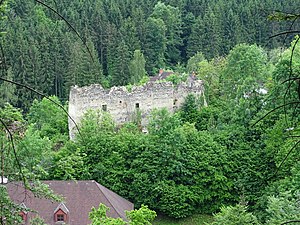Rein castle ruins
| Rein castle ruins | ||
|---|---|---|
|
The castle ruins in June 2019 |
||
| Alternative name (s): | Reun | |
| Creation time : | before 1040 | |
| Castle type : | Hilltop castle | |
| Conservation status: | ruin | |
| Place: | Gratwein street angel | |
| Geographical location | 47 ° 8 '2 " N , 15 ° 16' 54" E | |
|
|
||
The ruins of the fortification known as Burg Rein , also known as Reun , are located in the Eisbach district of the Gratwein-Straßengel community in the Styrian district of Graz-Umgebung , a little west of Rein Abbey . The history of the hill fort goes back to the middle of the 11th century. At the latest in the 14th or 15th century it was abandoned to decay and the existing fortifications were incorporated into the monastery complex of Rein Abbey.
Location
The ruins of the fortified courtyard are on a small hill to the west of Rein Abbey . The Ulrichsberg rises slightly to the north of the ruins and is dominated by the Pleschkogel . Between the ruins and the Ulrichsberg, the old road runs up to the Gleinalpe , which the weir used to protect.
history
The fortified Reun court was first mentioned between 1040 and 1060, when the fortification served as the seat of noble Waltfried. Count Waldo von Ruina, named in the founding deed of St. Lambrecht Monastery in 1103, may also have had his seat in Rein. But since he emigrated to Franconia shortly after the foundation of the monastery , in 1122 he left the fort in Rein to the Margrave Ottokar II in order to use the land belonging to it to found a monastery. These properties were used by Leopold I in 1129 to found Rein Abbey, and the farm served as the administrative center and to protect the road to the Gleinalpe . Leopold's widow Sophie received further properties belonging to Reun in 1135 from a Wolfker who was probably related to Count Waldo, which she handed over to the newly founded monastery. In 1276 the Wehrhof housed a gathering of Styrian and Carinthian noblemen, at which they swore allegiance and allegiance to the German King Rudolf I , the so-called pure oath .
The fortifications of the courtyard that existed in the 13th century were probably integrated into the monastery complex and are no longer recognizable today. The only remains of defensive walls that can still be identified today date from the 14th and 15th centuries. At that time at the latest, the farm was left to decay.
description
Today only sparse remains of the defensive walls from the 14th and 15th centuries can be seen.
Web links
- Entry via castle ruin Rein on Burgen-Austria
- Rein castle ruins. www.wehrbauten.at, accessed on February 28, 2017 (German).
Individual evidence
- ↑ a b c Entry about the castle ruin Rein on Burgen-Austria
- ↑ a b Rein castle ruins. www.wehrbauten.at, accessed on February 28, 2017 (German).

